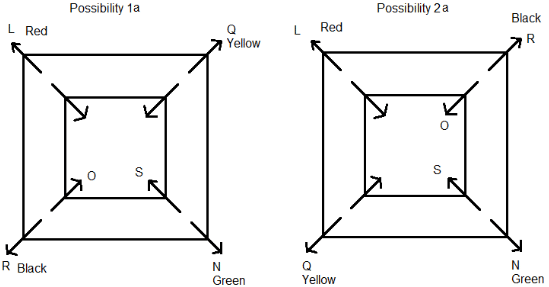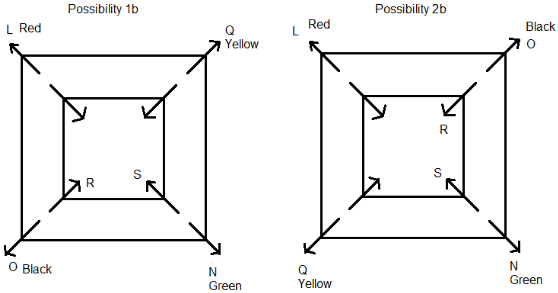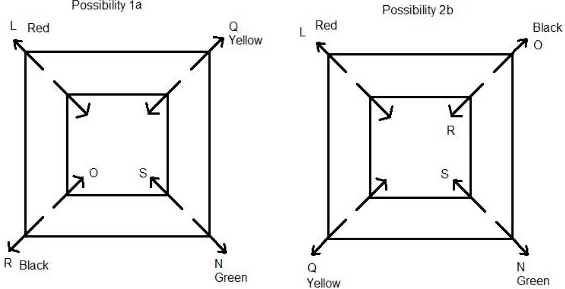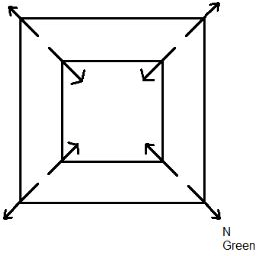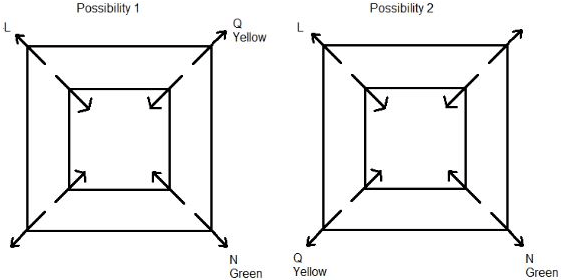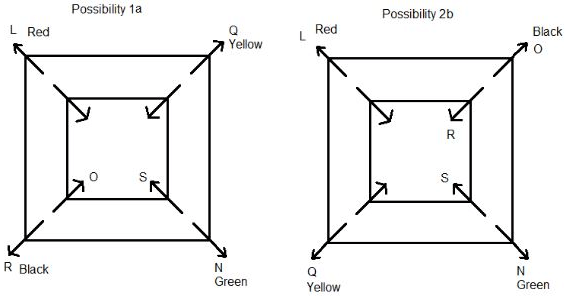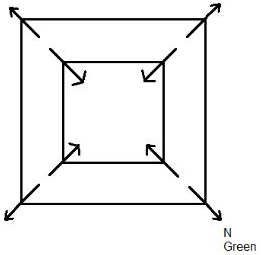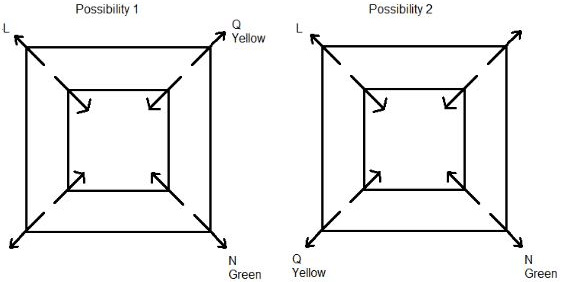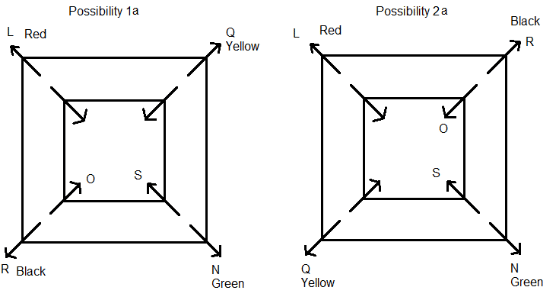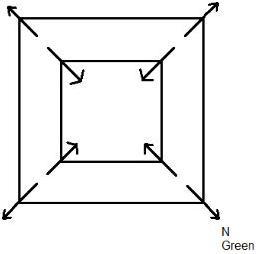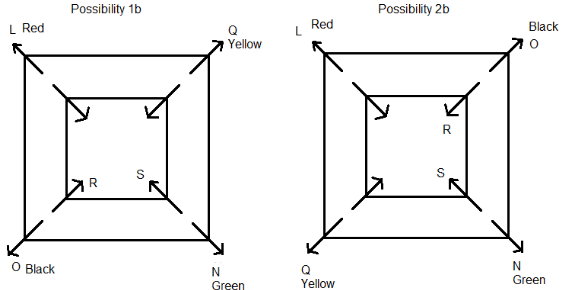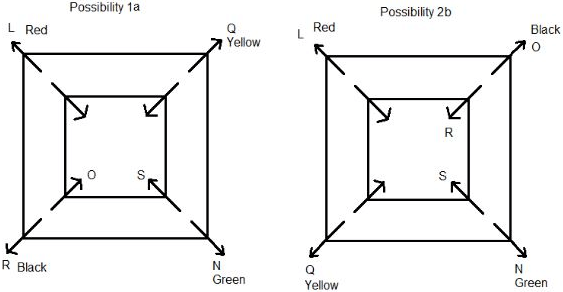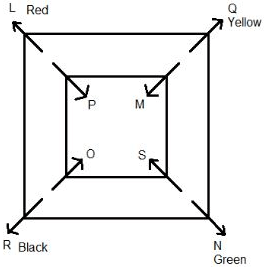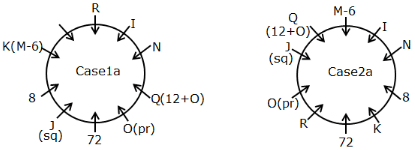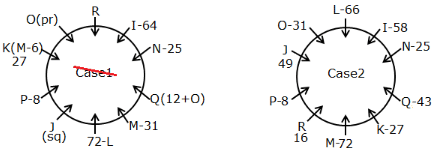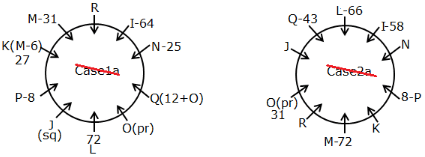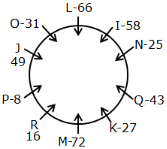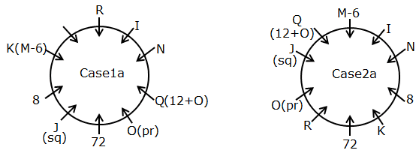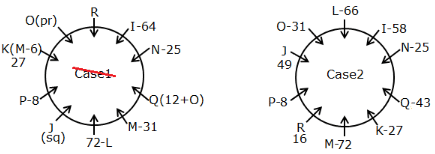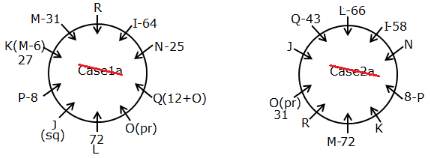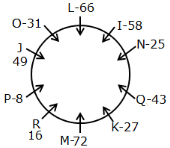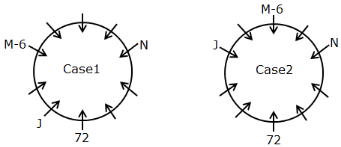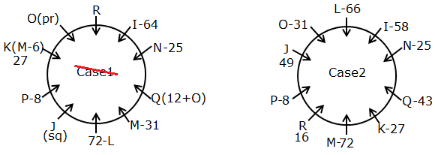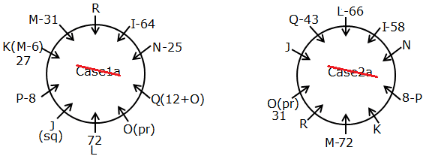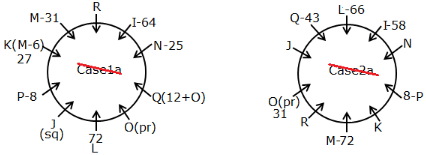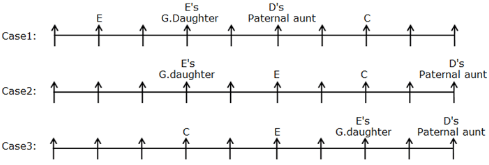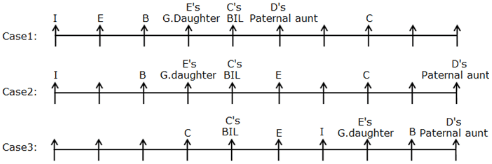SBI PO Mains Mock Test - 4 (New Pattern) - Bank Exams MCQ
30 Questions MCQ Test - SBI PO Mains Mock Test - 4 (New Pattern)
Directions: Study the following information carefully and answer the question.
There are eight persons L, M, N, O, P, Q, R and S sitting along two concentric squares. All the persons are sitting exactly at the corners. Those who are sitting in the outer square are facing away from the centre and those who are sitting in the inner square are facing towards the centre. There are four pairs and each pair has a male and a female. Every pair is wearing a different coloured T-shirt such as Red, Yellow, Green and Black, whereas within the pair they are wearing same coloured T-shirts. Each pair is facing away from each other, i.e. they are sitting at same corners of different squares. Females are sitting in the inner square and males are sitting in the outer square. N is wearing a Green coloured T-shirt and facing outwards. S is wearing either a Green or a Black coloured T-shirt. An immediate neighbour of O is wearing a Red coloured T-shirt. Only Q sits between L and N and is wearing a Yellow coloured T-shirt. R and O are in one pair. P is not wearing a yellow coloured T-shirt and is not to the immediate left of M. The one who sits to the immediate right of R is not wearing a Green coloured T-shirt.
Who is the pairing partner of L?
Directions: Study the following information carefully and answer the question.
There are eight persons L, M, N, O, P, Q, R and S sitting along two concentric squares. All the persons are sitting exactly at the corners. Those who are sitting in the outer square are facing away from the centre and those who are sitting in the inner square are facing towards the centre. There are four pairs and each pair has a male and a female. Every pair is wearing a different coloured T-shirt such as Red, Yellow, Green and Black, whereas within the pair they are wearing same coloured T-shirts. Each pair is facing away from each other, i.e. they are sitting at same corners of different squares. Females are sitting in the inner square and males are sitting in the outer square. N is wearing a Green coloured T-shirt and facing outwards. S is wearing either a Green or a Black coloured T-shirt. An immediate neighbour of O is wearing a Red coloured T-shirt. Only Q sits between L and N and is wearing a Yellow coloured T-shirt. R and O are in one pair. P is not wearing a yellow coloured T-shirt and is not to the immediate left of M. The one who sits to the immediate right of R is not wearing a Green coloured T-shirt.
Who sits to the immediate right of P?
Directions: Study the following information carefully and answer the question.
There are eight persons L, M, N, O, P, Q, R and S sitting along two concentric squares. All the persons are sitting exactly at the corners. Those who are sitting in the outer square are facing away from the centre and those who are sitting in the inner square are facing towards the centre. There are four pairs and each pair has a male and a female. Every pair is wearing a different coloured T-shirt such as Red, Yellow, Green and Black, whereas within the pair they are wearing same coloured T-shirts. Each pair is facing away from each other, i.e. they are sitting at same corners of different squares. Females are sitting in the inner square and males are sitting in the outer square. N is wearing a Green coloured T-shirt and facing outwards. S is wearing either a Green or a Black coloured T-shirt. An immediate neighbour of O is wearing a Red coloured T-shirt. Only Q sits between L and N and is wearing a Yellow coloured T-shirt. R and O are in one pair. P is not wearing a yellow coloured T-shirt and is not to the immediate left of M. The one who sits to the immediate right of R is not wearing a Green coloured T-shirt.
Which coloured T-shirt is worn by M?
Directions: Study the following information carefully and answer the question.
There are eight persons L, M, N, O, P, Q, R and S sitting along two concentric squares. All the persons are sitting exactly at the corners. Those who are sitting in the outer square are facing away from the centre and those who are sitting in the inner square are facing towards the centre. There are four pairs and each pair has a male and a female. Every pair is wearing a different coloured T-shirt such as Red, Yellow, Green and Black, whereas within the pair they are wearing same coloured T-shirts. Each pair is facing away from each other, i.e. they are sitting at same corners of different squares. Females are sitting in the inner square and males are sitting in the outer square. N is wearing a Green coloured T-shirt and facing outwards. S is wearing either a Green or a Black coloured T-shirt. An immediate neighbour of O is wearing a Red coloured T-shirt. Only Q sits between L and N and is wearing a Yellow coloured T-shirt. R and O are in one pair. P is not wearing a yellow coloured T-shirt and is not to the immediate left of M. The one who sits to the immediate right of R is not wearing a Green coloured T-shirt.
Who sits to the immediate right of R?
Study the following information carefully and answer the below questions
Input: 97184 Quite Since 61472 Often 56784 Ultra 83512 73948 Earth
Step I: 56784 Ultra 61472 Since 73948 Quite 83512 Often 97184 Earth
Step II: 14196 flrtz 15368 cnrsv 18487 fqrtv 20878 flntv 24296 hrtvz
Step III: 6361 djprx 8303 alpqt 7644 doprt 1608 djlrt 12362 fprtx
Step IV: 6631 alpqt 8330 djlrt 7644 djprx 8610 doprt 63221fprtx
Step V: 16 bnsuy 14 elovy 21elsvc 15 eqsvy14 gruxc
Step V gives the final output.
Input: Pause 54716 Games Scale 49376 89164 Noise 64572 Weird 75328
If Scale is related to 75328 in step I, 3241 is related to jlpqt in step III in a certain way, then in the same way which of the following is related to eptxc in step V?
Study the following information carefully and answer the below questions
Input: 97184 Quite Since 61472 Often 56784 Ultra 83512 73948 Earth
Step I: 56784 Ultra 61472 Since 73948 Quite 83512 Often 97184 Earth
Step II: 14196 flrtz 15368 cnrsv 18487 fqrtv 20878 flntv 24296 hrtvz
Step III: 6361 djprx 8303 alpqt 7644 doprt 1608 djlrt 12362 fprtx
Step IV: 6631 alpqt 8330 djlrt 7644 djprx 8610 doprt 63221fprtx
Step V: 16 bnsuy 14 elovy 21elsvc 15 eqsvy14 gruxc
Step V gives the final output.
Input: Pause 54716 Games Scale 49376 89164 Noise 64572 Weird 75328
What is the sum of the elements which are third from the left end in step III and second from the right end in step II?
Study the following information carefully and answer the below questions
Input: 97184 Quite Since 61472 Often 56784 Ultra 83512 73948 Earth
Step I: 56784 Ultra 61472 Since 73948 Quite 83512 Often 97184 Earth
Step II: 14196 flrtz 15368 cnrsv 18487 fqrtv 20878 flntv 24296 hrtvz
Step III: 6361 djprx 8303 alpqt 7644 doprt 1608 djlrt 12362 fprtx
Step IV: 6631 alpqt 8330 djlrt 7644 djprx 8610 doprt 63221fprtx
Step V: 16 bnsuy 14 elovy 21elsvc 15 eqsvy14 gruxc
Step V gives the final output.
Input: Pause 54716 Games Scale 49376 89164 Noise 64572 Weird 75328
How many alphabets are there in the alphabetical series between the letters which are first letter of the element which is second from the left end in step IV and the exact middle letter of the element which is third from the right end in step V?
Study the following information carefully and answer the below questions
Input: 97184 Quite Since 61472 Often 56784 Ultra 83512 73948 Earth
Step I: 56784 Ultra 61472 Since 73948 Quite 83512 Often 97184 Earth
Step II: 14196 flrtz 15368 cnrsv 18487 fqrtv 20878 flntv 24296 hrtvz
Step III: 6361 djprx 8303 alpqt 7644 doprt 1608 djlrt 12362 fprtx
Step IV: 6631 alpqt 8330 djlrt 7644 djprx 8610 doprt 63221fprtx
Step V: 16 bnsuy 14 elovy 21elsvc 15 eqsvy14 gruxc
Step V gives the final output.
Input: Pause 54716 Games Scale 49376 89164 Noise 64572 Weird 75328
What is the final outcome of the phrase “Weird 89164 Noise”?
Directions: In the following question, two statements numbered I and II are given. There may be a cause and effect relationship between the two statements. These two statements may be the effect of the same cause or independent causes. These statements may be independent causes without having any relationship. Read both the statements and mark your answer.
Statement I: The government has made the rules for the disposal of waste and other chemicals from the industries more stringent to keep a check on pollution level in the atmosphere.
Statement II: Complex reactions of chemicals such as sulphur dioxide and nitrogen oxide emitted from power plants, industries and automobiles escalate the level of particulate matter in the atmosphere.
Study the following information carefully and answer the below questions
Ten persons are sitting around a circular table facing the centre. Each of them scored different marks in the exam.
N sits third to the right of the one who scored 72 marks. Only three persons sit between N and J, whose mark is a square number. The one who scored 6 marks less than M sits second to the left of J. The mark scored by J is more than O but less than I. As many persons sit between the one who scored 8 marks and O as between O and I, who sits immediate right of N. Q, who sits fourth to the right of the one who scored 8 marks and scored 12 marks more than O, whose mark is a prime number. R, whose mark is an even number and sits three places away from Q. K sits second to the right of R and scored 2 marks than N. P and the one who scored 25 marks are facing each other. L scored 8 marks more than I. The mark scored by none of the persons is less than five. The mark scored by O is two less than half of the mark scored by L. The sum of marks scored by R and J is 65.
Conditions:
They are playing the dice game. Two persons are rolling the dice at the same time.
I. If two persons are getting an odd number, then their marks will be added to the person who sits second to the right of them.
II. If two persons are getting an even number, then their marks will be subtracted from the person who is facing them.
III. If one person gets an odd number and another person gets an even number, then their marks will be exchanged with the person who sits immediate left of them.
If the persons who sit third to the right of R and second to the left of J are rolling dice and both are getting an even number. Then what is the difference between the marks scored by them?
Study the following information carefully and answer the below questions
Ten persons are sitting around a circular table facing the centre. Each of them scored different marks in the exam.
N sits third to the right of the one who scored 72 marks. Only three persons sit between N and J, whose mark is a square number. The one who scored 6 marks less than M sits second to the left of J. The mark scored by J is more than O but less than I. As many persons sit between the one who scored 8 marks and O as between O and I, who sits immediate right of N. Q, who sits fourth to the right of the one who scored 8 marks and scored 12 marks more than O, whose mark is a prime number. R, whose mark is an even number and sits three places away from Q. K sits second to the right of R and scored 2 marks than N. P and the one who scored 25 marks are facing each other. L scored 8 marks more than I. The mark scored by none of the persons is less than five. The mark scored by O is two less than half of the mark scored by L. The sum of marks scored by R and J is 65.
Conditions:
They are playing the dice game. Two persons are rolling the dice at the same time.
I. If two persons are getting an odd number, then their marks will be added to the person who sits second to the right of them.
II. If two persons are getting an even number, then their marks will be subtracted from the person who is facing them.
III. If one person gets an odd number and another person gets an even number, then their marks will be exchanged with the person who sits immediate left of them.
If the person who is sitting second to the left of O and third to the left of K are rolling dice and both are getting an odd number, then what is the mark scored by the persons who sit second to the right of each of them?
Study the following information carefully and answer the below questions
Ten persons are sitting around a circular table facing the centre. Each of them scored different marks in the exam.
N sits third to the right of the one who scored 72 marks. Only three persons sit between N and J, whose mark is a square number. The one who scored 6 marks less than M sits second to the left of J. The mark scored by J is more than O but less than I. As many persons sit between the one who scored 8 marks and O as between O and I, who sits immediate right of N. Q, who sits fourth to the right of the one who scored 8 marks and scored 12 marks more than O, whose mark is a prime number. R, whose mark is an even number and sits three places away from Q. K sits second to the right of R and scored 2 marks than N. P and the one who scored 25 marks are facing each other. L scored 8 marks more than I. The mark scored by none of the persons is less than five. The mark scored by O is two less than half of the mark scored by L. The sum of marks scored by R and J is 65.
Conditions:
They are playing the dice game. Two persons are rolling the dice at the same time.
I. If two persons are getting an odd number, then their marks will be added to the person who sits second to the right of them.
II. If two persons are getting an even number, then their marks will be subtracted from the person who is facing them.
III. If one person gets an odd number and another person gets an even number, then their marks will be exchanged with the person who sits immediate left of them.
If the persons who sit second to the left of L and the one who sits immediate right of O, are rolling the dice and if one gets the number 3 and the other gets the number which is two less than the marks scored by the one who sits second to the left of M, then what is the sum of marks scored by the person who sits immediate left of each of them?
Study the following information carefully and answer the below questions
Ten persons are sitting around a circular table facing the centre. Each of them scored different marks in the exam.
N sits third to the right of the one who scored 72 marks. Only three persons sit between N and J, whose mark is a square number. The one who scored 6 marks less than M sits second to the left of J. The mark scored by J is more than O but less than I. As many persons sit between the one who scored 8 marks and O as between O and I, who sits immediate right of N. Q, who sits fourth to the right of the one who scored 8 marks and scored 12 marks more than O, whose mark is a prime number. R, whose mark is an even number and sits three places away from Q. K sits second to the right of R and scored 2 marks than N. P and the one who scored 25 marks are facing each other. L scored 8 marks more than I. The mark scored by none of the persons is less than five. The mark scored by O is two less than half of the mark scored by L. The sum of marks scored by R and J is 65.
Conditions:
They are playing the dice game. Two persons are rolling the dice at the same time.
I. If two persons are getting an odd number, then their marks will be added to the person who sits second to the right of them.
II. If two persons are getting an even number, then their marks will be subtracted from the person who is facing them.
III. If one person gets an odd number and another person gets an even number, then their marks will be exchanged with the person who sits immediate left of them.
Which of the following statement is not true with respect to the final arrangement?
Directions: A passage is given below followed by a possible inference, which can be drawn from the facts stated in the passage. You have to examine the inference in the context of the passage and decide upon its degree of truth or falsity.
Mark answer (A) if the inference is "definitely true", i.e. it properly follows from the statement of facts given.
Mark answer (B) if the inference is "probably true" though not "definitely true" in the light of the facts given.
Mark answer (C) if the "data is inadequate", i.e. from the facts given, you cannot say whether the inference is likely to be true or false.
Mark answer (D) if the inference is "probably false" though not "definitely false" in the light of the facts given.
Mark answer (E) if the inference is "definitely false", i.e. it cannot possibly be drawn from the facts given or it contradicts the given facts.
As costs of repayment and interest spike, exchequers can be wiped out. The most important reason why India was relatively insulated from the global meltdown of 2008-09 was because our capital controls restricted the amounts which the government and companies could have borrowed globally; this insulated us from the devastating downgrades and bond market movements that damaged European economies.
In the past, India has borrowed overseas in times of trouble. It floated quasi-sovereign bonds in 1991 during our economic crisis, in 1998 after the Asian crisis and in 2001 when the economy was weak and the rupee headed south.
Each time, the economy sprung back, not because of the loans but because of reforms. The only people, who will laugh their way to the bank, if the government decides to shop for loans, will be investment bankers, not the government or taxpayers. Today, with nearly $300 billion in reserves, and near-5% growth, there is no reason to panic and shop for loans abroad.
It is said that global confidence in India is fickle. Yet, FMCG giant Unilever is bringing in $4.5 billion to buttress its stake in its Indian arm, because it sees growth prospects here as better than elsewhere in the world. It is betting on India's growth prospects with hard cash. The government should reciprocate purposefully: clearing long pending projects, reforming sectors like coal and electricity and rolling out ambitious projects like the Delhi-Mumbai infrastructure corridor.
Global companies are investing in India despite weak investor confidence.
Read the information given below carefully and answer the questions that follow:
The landslide monitoring and early warning system developed by the Indian Institute of Technology (IIT) Mandi was reviewed by Prime Minister Narendra Modi during his visit to Himachal Pradesh. The Landslide Monitoring System provides soil movement alerts via hooters and blinkers installed on the road remotely via text message. Additionally, the system sends rainfall alerts in advance if more than 5 mm of rain is predicted. Landslides are predicted 10 minutes before they actually occur by monitoring changes in soil movement. The system also predicts extreme weather events with the help of artificial intelligence (AI) and machine learning.
Which of the following can be the best assumption as per the given information?
Read the information given below carefully and answer the questions that follow:
The landslide monitoring and early warning system developed by the Indian Institute of Technology (IIT) Mandi was reviewed by Prime Minister Narendra Modi during his visit to Himachal Pradesh. The Landslide Monitoring System provides soil movement alerts via hooters and blinkers installed on the road remotely via text message. Additionally, the system sends rainfall alerts in advance if more than 5 mm of rain is predicted. Landslides are predicted 10 minutes before they actually occur by monitoring changes in soil movement. The system also predicts extreme weather events with the help of artificial intelligence (AI) and machine learning.
Which of the following would strengthen the premise that such a system will prove useful?
Directions: Study the following information carefully and answer the question.
Ten players, namely, Anand, Bharat, Carlson, Dhoni, Rohit, Federer, Gambhir, Hardik, Ishant and Jonty are sitting in a row facing north. All of them earn different amounts (in lakhs per hour) for an advertisement viz. 3, 4.5, 7, 8.5 and 10. No more than three players receive same amount.
Hardik sits behind Dhoni. Gambhir sits behind Bharat. Three players are sitting between Rohit and Ishant. Three players are sitting between Gambhir and Bharat. As many players sit before Rohit as after Jonty. Five players sit between Dhoni and Hardik. Federer sits behind Anand. Bharat sits either at the beginning or at the end. Rohit sits adjacent to Gambhir. Federer does not sit at any extreme end.
S # T means 'S receive more income than T'.
S @ T means 'S receive less income than T'.
S $ T means 'S receives same cash as T'.
Hardik $ Dhoni, Dhoni # Carlson, Carlson # Bharat, Bharat $ Rohit $ Gambhir, Gambhir @ Carlson $ Ishant, Rohit # Anand # Jonty $ Federer
How many players are sitting between Dhoni and Jonty?
Directions: Study the following information carefully and answer the question.
Ten players, namely, Anand, Bharat, Carlson, Dhoni, Rohit, Federer, Gambhir, Hardik, Ishant and Jonty are sitting in a row facing north. All of them earn different amounts (in lakhs per hour) for an advertisement viz. 3, 4.5, 7, 8.5 and 10. No more than three players receive same amount.
Hardik sits behind Dhoni. Gambhir sits behind Bharat. Three players are sitting between Rohit and Ishant. Three players are sitting between Gambhir and Bharat. As many players sit before Rohit as after Jonty. Five players sit between Dhoni and Hardik. Federer sits behind Anand. Bharat sits either at the beginning or at the end. Rohit sits adjacent to Gambhir. Federer does not sit at any extreme end.
S # T means 'S receive more income than T'.
S @ T means 'S receive less income than T'.
S $ T means 'S receives same cash as T'.
Hardik $ Dhoni, Dhoni # Carlson, Carlson # Bharat, Bharat $ Rohit $ Gambhir, Gambhir @ Carlson $ Ishant, Rohit # Anand # Jonty $ Federer
What will be the sum of the amounts earned by Anand, Federer and Ishant?
Directions: Study the following information carefully and answer the question.
Ten players, namely, Anand, Bharat, Carlson, Dhoni, Rohit, Federer, Gambhir, Hardik, Ishant and Jonty are sitting in a row facing north. All of them earn different amounts (in lakhs per hour) for an advertisement viz. 3, 4.5, 7, 8.5 and 10. No more than three players receive same amount.
Hardik sits behind Dhoni. Gambhir sits behind Bharat. Three players are sitting between Rohit and Ishant. Three players are sitting between Gambhir and Bharat. As many players sit before Rohit as after Jonty. Five players sit between Dhoni and Hardik. Federer sits behind Anand. Bharat sits either at the beginning or at the end. Rohit sits adjacent to Gambhir. Federer does not sit at any extreme end.
S # T means 'S receive more income than T'.
S @ T means 'S receive less income than T'.
S $ T means 'S receives same cash as T'.
Hardik $ Dhoni, Dhoni # Carlson, Carlson # Bharat, Bharat $ Rohit $ Gambhir, Gambhir @ Carlson $ Ishant, Rohit # Anand # Jonty $ Federer
How many players are sitting ahead of Federer?
Study the following information carefully and answer the below questions
A family consist of ten members and three generations are sitting in a linear row facing north.
The one who is the paternal aunt of D sits fourth to the right of E. Neither E nor C sits at the extreme ends. Only one person sits between E and her only granddaughter. The number of persons sitting to the left of E’s granddaughter is one more than the number of persons sitting to the right of C, who has no siblings. C is a male. D, who is not a child of A and is the grandson of I. The one who is the sister-in-law of F is a child of B. The number of persons sitting between C and his only brother-in-law is one less than the number of persons sitting between C’s brother-in-law and I, where C and I are not sitting together. B, who is the mother of E’s daughter-in-law and sits second to the right of I. F and her son D are sitting together. F does not have any siblings. The one who is the maternal uncle of J sits second to the left of F and is not sitting at the extreme ends. H is the niece of the one who is the nephew of G, who is the brother of B.
Four of the following five are alike in a certain way based on the given arrangement and thus form a group. Which one of the following does not belong to the group?
In March 2025, Paytm recently launched a new initiative in collaboration with the State Bank of India (SBI) for Systematic Investment Plans (SIP). Which of the following statements is correct about the initiative?
1. The initiative allows investors to start SIPs with a minimum investment of ₹500.
2. It offers various SIP options, including daily, weekly, or monthly plans to suit diverse financial needs.
3. The scheme is open only to existing Paytm Money customers.
In June 2025, Bajaj Allianz General Insurance has introduced India’s first state-wise health insurance policies, offering customized coverage based on regional healthcare needs. Which states and territories will the policies cover?
In July 2025, which of the following statements about Pakistan's assumption of the UN Security Council Presidency for July 2025 are correct?
1. Pakistan assumed the presidency of the UN Security Council for July 2025 as part of its two-year term as a non-permanent
member.
2. The presidency rotates monthly among the 10 non-permanent members of the Security Council in alphabetical order.
3. Pakistan will focus primarily on strengthening international economic collaboration during its tenure as the UNSC president.
In June 2025, Recognizing the importance of skill development in banking services, India’s public sector bank has partnered with an international financial standards body to train its employees. Which bank has signed an MoU with FPSB India to certify over 2.36 lakh employees with the globally recognized Certified Financial Planner (CFP) qualification?
In April 2025, the Rajiv Gandhi International Airport (RGIA) in Hyderabad achieved a prestigious carbon management certification. What level of the Airport Carbon Accreditation (ACA) did RGIA receive?
In May 2025, the government of Uttarakhand secured a substantial amount of funding from the European Investment Bank (EIB) for urban infrastructure development in the state. This funding will support projects aimed at improving water supply and sewage systems in multiple cities. How much funding did Uttarakhand secure for these urban projects?
In May 2025, the Madhya Pradesh (MP) government approved the "Rah-veer" scheme, aimed at promoting road safety and religious traditions surrounding Adi Shankaracharya's statue. The scheme includes financial rewards for individuals who assist road accident victims. Which of the following statements regarding the "Rah-veer" scheme is correct?
1. The "Rah-veer" scheme will reward individuals with Rs. 25,000 for helping road accident victims reach a hospital.
2. The scheme is only applicable to residents of Indore and not the entire state of Madhya Pradesh.
3. The "Rah-veer" scheme is a part of the 300th birth anniversary celebrations of Devi Ahilyabai Holkar.
Which of the following statements is correct?
In June 2025, During Prime Minister Narendra Modi's three-nation visit to Cyprus, Canada, and Croatia in June 2025, he focused on strengthening bilateral relations, enhancing cooperation across various sectors, and promoting India’s global presence. As part of this visit, several Memorandums of Understanding (MoUs) were signed between India and Croatia. Which of the following agreements was NOT one of the MoUs signed during Prime Minister Narendra Modi’s visit to Croatia?
Union Budget 2025–2026 proposed the establishment of top-tier skilling hubs that will work with global partners to equip youth for domestic and international employment. These centres will focus on cutting-edge technology and advanced skill sets. How many National Centres of Excellence for skilling are planned under this initiative?
In July 2025, NASA confirmed the discovery of the interstellar comet 3I/ATLAS, which is the third known interstellar object to pass through our solar system. This discovery provides a unique opportunity to study objects that originate from outside our solar system. What is the name of the telescope that discovered the comet 3I/ATLAS?




